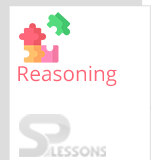 Description
Description
Mathematical operations chapter mainly deals with the fundamental operations like addition, subtraction, multiplication, and division and also statements such as 'less than', 'greater than', 'equal to', 'not equal to' etc. are represented by symbols, different from the usual ones.
The questions including these operations are set utilizing fake symbols.The applicant needs to substitute the genuine signs and tackle the questions likewise, to get the answer.
Reasoning Ability -BANKING|SSC|RAILWAYS|INSURANCE|RECRUITMENT EXAMS – EBOOKS
 Concepts
Concepts
Mathematical operations questions are categorized by following types. They are:
1. Problems solving by substitution.
2. Interchange of signs and numbers.
3. Deriving the appropriate conclusions.
4. Trick based mathematical operations.
NOTE: Simplification is based on BODMAS rule, where
B ->Brackets,
O -> Of,
D -> Division,
M -> Multiplication,
A -> Addition, and
S -> Subtraction.
BODMAS is about simplifying an expression by firstly removing the brackets in the order i.e. (), {}, []. Removal of brackets is followed by addition, subtraction, multiplication, division, square roots, cube roots, powers, cancellation of numerator/ denominator and so on.
1. Problems solving by substitution:
In this kind, a competitor is given with substitutes to different numerical symbols, followed by a question including estimation of an expression or picking the right/wrong mathematical statement. The competitor is required to put in the genuine signs in the given mathematical statement and after that solve the questions as required.
2. Interchange of signs and numbers:
In this kind, the given comparison gets to be right and completely adjusted when either two signs of the mathematical statement or both the numbers and the signs of the mathematical statement are interchanged. The competitor is required to locate the right combine of signs and numbers from the given choices.
3. Deriving the appropriate conclusions:
In this kind of questions, certain relations between various arrangements of components is given(in terms of 'less than', 'greater than' or 'equal to'), utilizing either the genuine symbols or substituted symbols. The competitor is required to examine the given statements and after that choose which of the relations gives as choices takes after from those given statements.
4. Trick based mathematical operations:
The questions depend on straightforward numerical operations that don't go under any of the above given types covered here. These questions can be founded on a few diverse examples.  Model
Problems
Model
Problems
Model 1: If '+' means 'multiplied by', 'x' means 'minus', '÷' means 'plus' and '-' means 'multiplied by', then find the value of the expression 500 x 8 - 4 + 14 ÷ 72 ?
Solution:
Given expression:
500 x 8 - 4 + 14 ÷ 72
Now, by assigning the proper signs in the given expression,
500 - 8 ÷ 4 x 14 + 72
⇒ 492 ÷ 4 x 14 + 72
⇒ 123 x 14 + 72
⇒ 1722 + 72
⇒ 1794
Therefore, 500 x 8 - 4 + 14 ÷ 72 = 500 - 8 ÷ 4 x 14 + 72 = 1794
Model 2: If the equation is 10 - 2 + 9 x 2 ÷ 4 = 19. Then which of the following symbols satisfy the equation after replacing '-' and '÷' with optional symbols given?
a) – and ÷
b) – and +
c) ÷ and -
d) × and ÷
Solution:
Given that
Equation is 10 - 2 + 9 x 2 ÷ 4 = 19
Consider the option(a) i.e. replace '-' with '÷' and '÷' with '-'
Take L.H.S side of given equation
10 - 2 + 9 x 2 ÷ 4
Now, after interchanging
10 ÷ 2 + 9 x 2 - 4
⇒ 5 + 9 x 2 - 4
⇒ 5 + 18 - 4
⇒ 19
L.H.S. = R.H.S.
Therefore, option(a) is the correct option.
Model 3: If P + Q > S + T and Q + S > P + T, then what satisfy the given equations?
Solution:
Given that,
P + Q > S + T ---- (i)
Q + S > P + T ---- (ii)
Add equations (i) and (ii)
Then,
P + Q + Q + S > S + T + P + T
P + 2Q + S > S + 2T + P
2Q > 2 T
Q > T
Therefore, Q > T satisfy the given equations.
Model 4: If 8 × 6 × 4 = 648 and 3 × 6 × 5 = 653, then what is 3 × 9 × 8 ?
Solution:
Given that
8 × 6 × 4 = 648 and 3 × 6 × 5 = 653
From given expressions it is clear that
First number in LHS side is last number for RHS side, similarly second is first and last one is in the middle.
Similarly,
3 × 9 × 8 = 983.
Model 5: If * means 'is greater than', @ means `is less then’, and $ means 'is equal to' and if a $ b and b @ c, then find the relation?
Solution:
Given that
* means 'is greater than'
@ means `is less then’
$ means 'is equal to'
Consider a $ b and b @ c
Replace the symbols with the meaning given against them.
Then, a $ b and b @ c would become a = b and b < c, then c > b or c > a
i.e., c * b, c * a



